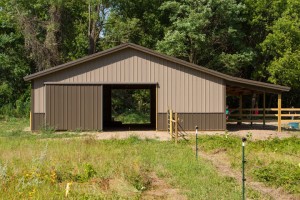Condensation and moisture issues in any building can be problematic. No one purposely designs a building with an idea to have dripping from under roof condensation, or mold and mildew from trapped moisture.
Hansen Pole Buildings’ client and loyal reader KURT in SAINT HELENS writes:
“Hello,
Question about roof insulation. Plan on insulating 2″ double-laminated with WMP-VR on one side and FSK-HD Foil facing on the other. Layers for the roof will consist of metal roofing, 30# roofing felt, 1/2 plywood and the insulation. Will I have moisture issues with this configuration?
Thanks for your input.”
Mike the Pole Barn Guru responds:
Thank you for your question Kurt, obviously you have given a great deal of thought to condensation and moisture issues in your new post frame building.
Your layer of plywood and felt will provide a thermal break preventing any warm moist air inside of your building from contacting with a cooler steel roof.
For those interested, here is some light reading about WMP-VR https://www.hansenpolebuildings.com/2014/10/metal-building-insulation-2/, a faced metal building “insulation”.
FSK facing, or foil-scrim-kraft is a flame retardant vapor-barrier. It is one of the most commonly used facings in today’s insulation industry. During manufacturing processes of an FSK facing, a layer of lightweight aluminum foil is layered against a tri-directional, reinforcing fiberglass scrim (yarn) and then paired with a final layer of natural brown kraft paper. This is all laminated together using a flame-retardant adhesive.
Once this process is complete, facing is rolled into a giant master roll and delivered to a fiberglass manufacturing facility. This is where manufactured fiberglass insulation is adhered to facing’s kraft paper side.
FSK facing is most commonly utilized with duct wrap, duct board, and mechanical spin-glas boards on outward-facing, exposed surfaces of HVAC ductwork. This FSK facing not only serves as a vapor-barrier to facilitate condensation control, but it is also a protective barrier for fiberglass insulation itself. Aluminum foil gives FSK its distinctive silver color and can typically be easily recognized on any HVAC system.
This two inch thick metal building “insulation” is going to be an unnecessary expense and will provide little or no actual insulating value. As long as you have adequate ventilation (both intake and exhaust) and your concrete floor has a well- sealed high quality vapor barrier below it, you should not experience moisture issues. Keep in mind – in the months immediately following pouring your concrete slab, expect to have excess moisture within your building. Once your concrete floor has cured, these issues should go away.










This was very interesting. I have been speaking with a Quonset metal hut dealer, and they “highly recommended” putting insulation on the inside of the steel building. I know quite a bit about insulation in a home, and the very thin insulation seemed to me like it wouldn’t be very effective. I know in homes you usually need 12″ to 14″ to really see benefits. Also in a science fair project I did with my daughter, we compared 8 inches of insulation with radiant barrier foil, using a 250 watt infrared heat lamp, and although the insulation slowed down the heat transfer, the temperature probe eventually got hot after many hours. However, interesting enough, the radiant barrier foil rejected the heat even after hours. Our conclusion was radiant barrier foil is more effective than insulation. I wonder how you could install radiant barrier foil on a steel building? I know you need at least a 1″ air gap between the foil and steel…
The clue to reflective radiant barriers working is they must be 100% air sealed and have a significant dead air space between the barrier and the surface being heated or cooled. Tests I have seen were usually around six inches of dead air. Outside of a controlled laboratory environment, I just do not see it working from a practicality standpoint.